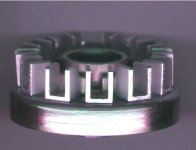teklektik said:
Kingfish said:
That could work via the axle, and there would also need to be an oil-scrubber or drip-line feedback: Several industrial systems work that way to solve similar problems. When you think about it, ICEs pull mild vacuum on the crankcase via the intake manifold.
Well, yes they do, but not to solve a similar problem - it's to address pollution from blow-by not shaft seal leaks.....
Yes – definitely true; that’s a primary goal.

However the technique was employed on some motors before the EPA came into creation – and it had the small legitimate effect of eliminating an extra seal at each shaft interface.
The problem with hub motors is that they are not normally vented, so pressure and vacuum can and do accumulate. The axle journals are not well finished when compared to ICE crankshafts, and the seals employed in a hub cover are for debris and moisture.
Useful diagram: From the SKF catalog,
this seal exceeds the stock unit shipped with a 9C hub.
In normal engines, there will be a specialty seal having a dust lip and a sealing lip, or two seals organized in such a way to reduce leakage/contamination into and out of the system. The journals will be well-finished and polished to avoid premature breakdown. Pulling a light vacuum can reduce cost in part fabrication; it’s a gimmick that has merit in many mechanical designs where leakage is verboten.
Returning to the conversation at hand, attesting for 9C hubs (I own several), they cannot be pressure-sealed through the axle without overt effort beyond the typical DIY tinkerer on ES. A machine shop could possibly do it, fabricate a new axle, manufacture new covers, and assemble with the correct components, etc. If the periphery of the cover is sealed (completely achievable), all that remains is a method to prevent leakage to the exterior via the axle when the motor is in a positive-pressure state.
What about just venting through the axle via a capillary tube up to an accumulator, say... the size of a CO2 cartridge which is vented to the atmosphere through a porous filter? Oil vapor travels into the accumulator, the pressure is vented, and when the reverse is true the oil would draw back into the system. No pump needed. Caveat: The vent would need protection against direct moisture.
Still, for this to work properly, it would be optimum if the journal was better polished.
My ½ W. Cup empty… considering another pot.
KF



